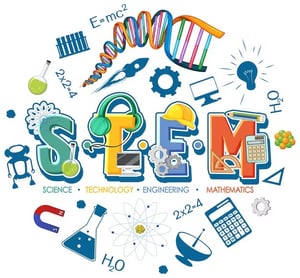No one likes dealing with problems, especially on a regular basis. So if that’s the case, why subject our kids to problem solving?
There are so many published studies talking about the benefits of problem-solving activities for kids. Plenty of child development experts insist on introducing children to intentional – but hypothetical – problems and encouraging them to solve them. Countless institutes and organizations put out free projects and resources to help kids practice crafting solutions.
Are there really benefits to continuous problem-solving? Or are we just subjecting the younger generation to unnecessary pressure?
Table of Contents
What is Problem Solving?
The technical definition of Problem Solving, as defined by ASQ, is the “act of defining a problem; determining the cause of the problem; identifying, prioritizing, and selecting alternatives for a solution; and implementing a solution.”
So problem-solving is, quite literally, the process of finding a solution to a problem. But, as you can see from the definition, it’s not quite as straightforward as we would like. In order to solve the problem, one needs to first recognize and acknowledge that the problem exists.
Once that’s done, they then move on to understanding the problem. Which, for the sake of brevity, we won’t break down anymore because there’s a lot involved. Analyzing, understanding, identifying … there’s quite a bit to it, so a general blanket term of “understanding” the problem works here.
Once the problem has been acknowledged and properly understood, then you would move on to the actual process of finding a solution.
What are Problem Solving Skills?
Contrary to what one might think, problem-solving skills is actually a blanket term for skills that one uses when solving a problem. These skills as a whole dictate one’s ability to quickly and correctly move through the problem-solving process to create a viable solution.
Here are a few examples of problem-solving skills:
- Creativity
- Analytical Thinking
- Logical Reasoning
- Decision-Making Skills
- Communication Skills
- Lateral Thinking
- Initiative
Related Reading:
In some cases, the problem you come up against would only need you to utilize one or two skills. In other cases – especially with more complex problems – three or more would be necessary. It all really depends on the situation.
Why Is Problem Solving an Important Skill to Develop?
Speaking practically, the ability to recognize a problem and develop a viable solution in response is something we all have and need to improve constantly—not just kids!
Problems for children may come in the form of learning how to tie their shoelaces or how to spell Mississippi. Problems for teenagers may be stubborn acne or socializing. For young adults and adults, problems could be filing taxes, finding roommates, or meeting a seemingly impossible deadline at work.
Whatever the case may be, it’s always good to have the skills, knowledge, and experience needed to solve a problem in the most effective way possible.
For very young children, developing problem-solving skills at an early age can prepare them for bigger challenges when they’re older. They’ll learn the importance of decisive decision-making. They’ll master the art of deduction and logical reasoning. They’ll be comfortable communicating their thought process to their peers and colleagues.
The more a child learns how to analyze a situation and break it down into manageable steps with the intent of finding a solution, the easier it’ll get. Practice makes perfect, after all!
But how does one go about learning and developing problem-solving skills?
There are two ways; incidentally – which basically refers to problems that naturally occur – and through guided opportunities – or problems that are given intentionally with the objective to practice those skills.
In this article, we’re going to cater to the second way by listing some great problem-solving activities you can use to keep your kids’ skills sharp.
Let’s get started!
I. Interactive Websites/Online Games

One of the best ways for kids to flex their problem-solving muscles is through interactive digital games.
Related Reading:
Games that are specifically designed to develop skills like creativity, logical reasoning, and/or lateral thinking are great platforms for your kid to flex their problem-solving muscles.
Plus, they’re incredibly effective because of their entertaining nature. Kids see them as digital media they can play with—and not tasks that they need to complete.
Here are a couple of awesome websites that offer problem-solving activities in the form of digital, interactive games:
At first glance, this website may look a little dated. However, don’t let appearances fool you; the options they have are quite extensive and very well-made!
There’s a wide variety of games that have very clear instructions and simple objectives. But don’t think simple means easy, in this case. The games on this website are anything but. I tried my hand at Word Funnel – an activity listed under their Word Games category – and I couldn’t get past level 2.
If you – or your child – enjoy variety, simplicity, and most importantly, a good challenge, we can’t recommend this website enough. The five different categories, with an average of ten games per category, pretty much guarantee you’ve got plenty of options to try and explore!
This one shares the same (or at least, a similar) concept with The Problem Site. You have a variety of different games to choose from—all with different themes, different objectives, and different subject matter.
For instance, OddSquad’s Code Breaker requires players to figure out the pattern in a given number sequence, which makes it a math game. The Cat in the Hat’s Corn Maze Craze, on the other hand, has players mapping out the best routes to help The Cat make it out of the maze, which requires visualization and strategy.
We highly recommend this site if your child is a big fan of the PBS Kids network and/or knows the colorful characters they feature here!
Don’t let the simple setup fool you—this activity is really tough!
The idea of Magic Squares is to fill up the squares with the given numbers so that the totals of each row, column, and diagonal are the same. It’s typically a 3×3 grid, although some versions of this activity give bigger options (i.e., 5×5, 7×7, etc.).
It may seem easy at first but for first-timers? It’s a real head-scratcher. If your child loves number puzzles like this, though, this should be a fun and engaging challenge!
Plus, if you solve it, you get to claim a (digital) trophy.
II. Computer Coding/Programming

If you’re familiar with coding, then you already know; programming is all about problem-solving. In fact, one could argue that all codes are solutions since they’re basically written instructions for a computer to follow.
Related Reading:
- Coding for Kids: 5 Reasons It’s More Important Than You Think
- Coding for Kids: The Ultimate Guide for Parents
If the codes are written well, the computer should have no issue carrying out the orders. But if it can’t understand the code, then there are probably bugs. In this case, it would still be the programmer’s responsibility to find them and take them out.
Basically, the whole programming process is fraught with problem-solving exercises. Your first problem would be figuring out what you want the computer to do. This helps you conceptualize your code.
Your next problem would be designing and writing the actual code. This is where programming knowledge and experience comes in. Do you know what terms to use? Do you know what order or sequence to follow? Do you know what will trigger the code?
The process doesn’t end when the code’s written, either. Any programmer will tell you that written code so rarely comes out perfect the first time. As we mentioned earlier, bugs – i.e., glitches or errors in the programming – are expected. So the programmer’s next problem is how to find the bugs and how to fix them.
As kids learn to code, running into problems – and consequently solving them – becomes a regular occurrence. This level of repetitiveness can help them get used to the concept and feeling of having to tackle issues head-on.
III. Hour of Code

This is related to our previous recommended activity; coding.
The Hour of Code started as a sixty-minute introduction to Computer Science. The original intent of the program was to compress, simplify, and clarify the basics of code to make it more approachable and more accessible to curious individuals.
Hour of Code has now become a worldwide collective supported by over 400 partners and 200,000 educators worldwide. It stays true to its origins by celebrating computer science and encouraging students to get into coding by releasing hour-long coding activities.
Related Reading:
If your child is learning how to code, the projects on the Hour of Code website may help them refine their coding skills and, as a result, further develop their problem-solving skills. And since these professionally-selected coding projects shouldn’t take your kids more than an hour to figure out, they make excellent refresher and/or testing courses.
IV. Sudoku/Crossword Puzzles

Sudoku puzzles are similar to Magic Squares in that they’re both number-placement puzzles. The difference lies in their setup and objective.
Classic Sudoku puzzles take place on 9×9 grids. These grids are further divided into smaller 3×3 grids.
Whereas Magic Squares require that the totals of all rows, columns and diagonals are equal, Sudoku puzzles require that all columns, rows, and 3×3 grids contain the digits 1 through 9 without repeating any digit.
You’re also given a few default digits to start with, and those will serve as your guide. You cannot change them to fit your pattern.
Say, for example, there’s already a default 3 in the second row, fifth column. This means that the number 3 cannot appear again in the whole second row and the whole fifth column.
You can see how such an activity would encourage the use of problem-solving skills. Logical reasoning, sequencing, pattern identification, mathematics … there’s a lot that comes into play when deciding which numbers go where.
Experts also point out that solving Sudoku puzzles requires the puzzler to be methodical and observant—two characteristics that can be incredibly beneficial to have when solving problems.
Related Reading:
V. LEGO/General Building Blocks

Whether they’re following instructions or they’re just free-handing it, kids can actually practice their problem-solving skills when they sit down with LEGO blocks.
LEGO constructs are, at their core, just big, 3D puzzles. But they’re an excellent problem-solving activity because they use so many problem-solving skills.
Let’s put it this way; the player needs to figure out how to turn multiple pieces of small, brightly-colored blocks of different sizes into one seamless, cohesive unit. That, in itself, already sounds pretty tough. Add on to that the actual construction process and you’ve got your hands full.
Aside from sequencing, spatial awareness, and fine motor skills, you also need persistence, attention to detail, deep comprehension, and trial-and-error … just to name a few.
Even if the instructions do give you a general guide, building the construct is more than just following directions. Why do you think there are different age level recommendations for different LEGO sets? If it was as easy as following a few sheets of paper, anyone could do it.
If your kid enjoys tinkering, a couple of different LEGO sets could be an excellent avenue for them to hone their problem-solving skills. If the two of you build it together, it would also make for great bonding moments. And, who knows? You might be able to dust off a skill or two in the process!
Conclusion
At the end of the day, problem-solving is a skill that we all possess. It’s not like creative or musical talents, where you’re either born with them or you’re not. We are all capable of analyzing a situation, recognizing the root cause of the issue, and pulling together whatever resources we have to create a solution. It’s a skill we all acquire early on.
How well-developed it becomes depends entirely on internal impulse and external factors.
Some studies suggest preschool as the best time to start introducing kids to guided problem-solving opportunities. Again, here are our top five recommendations:
- Interactive Websites/Online Games
- Computer Coding/Programming
- Hour of Code
- Sudoku/Crossword Puzzles
- LEGO/General Building Blocks
Learning early – and continuing the process – will, without a doubt, benefit your child both in school and beyond. But, with that said, don’t forget to ease up every now and then! Remember, activities don’t have to be formative or geared towards development all the time. It’s okay to let your kids play games that have no immediately obvious benefit. It’s okay to let them indulge in “mindless” games from time to time. Balance is key, after all!

















